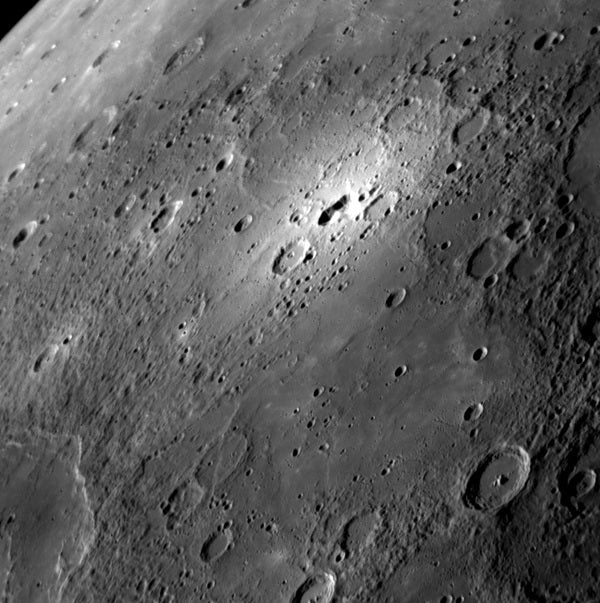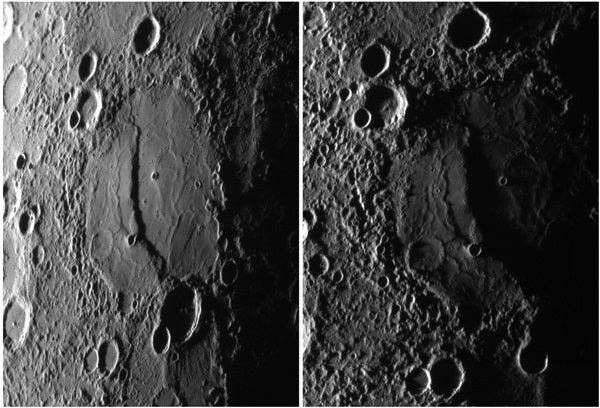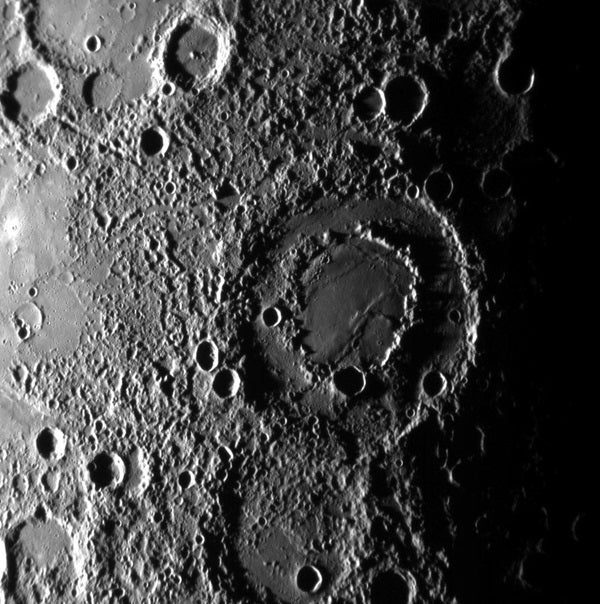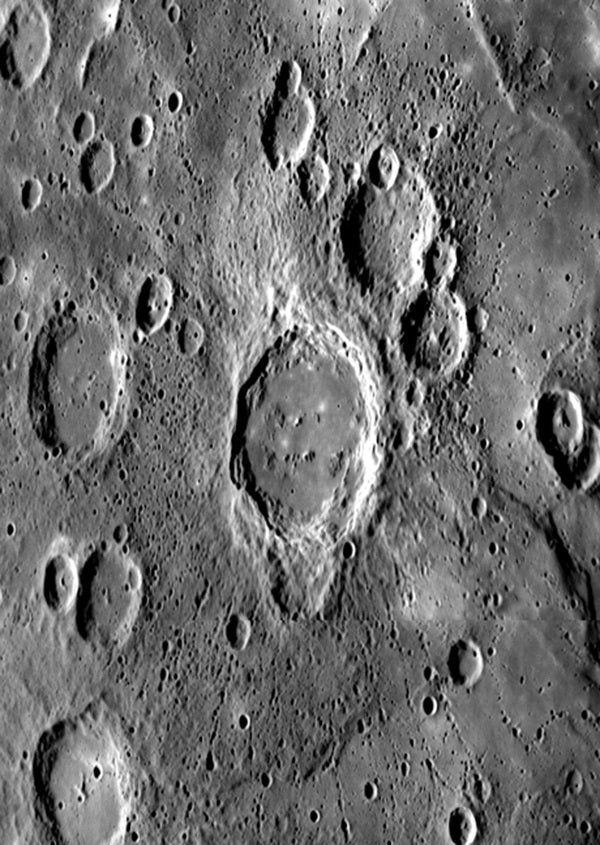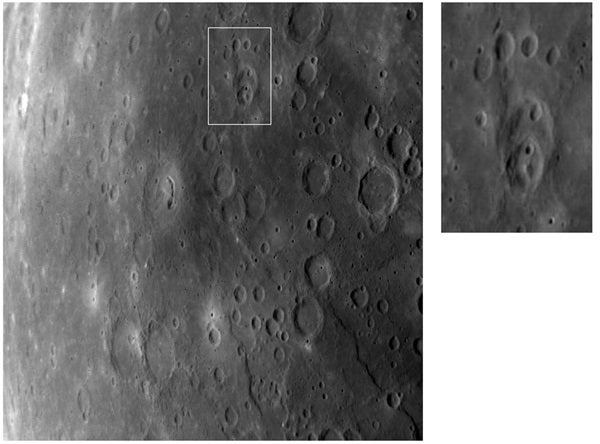October 1, 2009
A bright spot in the latest imaging
Humans have now had three views of the bright area shown near the top center of this image. The first view was as a mere tiny bright spot seen in telescopic images of Mercury obtained from Earth by astronomer Ronald Dantowitz. The second view was obtained by the MESSENGER Narrow Angle Camera during the spacecraft’s second Mercury flyby October 6, 2008. At that time, the bright feature was just on the planet’s limb (edge) as seen from MESSENGER. Now MESSENGER has provided a new, even better view. The geometry of MESSENGER’s third Mercury flyby allows us to see the feature and its surroundings in greater detail, including the smooth plains in the foreground and the rim of a newly discovered impact basin at lower left. Surprisingly, at the center of the bright halo is an irregular depression, which may have formed through volcanic processes. Color images from MESSENGER’s Wide Angle Camera reveal that the irregular depression and bright halo have distinctive color. This area will be of particular interest for further observation during MESSENGER’s orbital operations starting in 2011.
A bright spot in the latest imaging
Humans have now had three views of the bright area shown near the top center of this image. The first view was as a mere tiny bright spot seen in telescopic images of Mercury obtained from Earth by astronomer Ronald Dantowitz. The second view was obtained by the MESSENGER Narrow Angle Camera during the spacecraft’s second Mercury flyby October 6, 2008. At that time, the bright feature was just on the planet’s limb (edge) as seen from MESSENGER. Now MESSENGER has provided a new, even better view. The geometry of MESSENGER’s third Mercury flyby allows us to see the feature and its surroundings in greater detail, including the smooth plains in the foreground and the rim of a newly discovered impact basin at lower left. Surprisingly, at the center of the bright halo is an irregular depression, which may have formed through volcanic processes. Color images from MESSENGER’s Wide Angle Camera reveal that the irregular depression and bright halo have distinctive color. This area will be of particular interest for further observation during MESSENGER’s orbital operations starting in 2011.
Evening shadows
The MESSENGER images to the left were taken on approach to Mercury during the spacecraft’s second (left) and third (right) flybys. The image from the second flyby was featured in an earlier release. The image on the right was taken about 75 minutes before MESSENGER’s closest approach. The two images cover nearly the same terrain, but for the right image the Sun’s illumination is more nearly grazing (local time is almost sunset) and the viewing perspective of the spacecraft is more nearly vertical. The large impact crater bisected with a prominent scarp or cliff is the same feature in both images. Because of Mercury’s rotation between the two encounters, the position of the crater in the right image is nearly at the terminator (the division between the dayside and night side of the planet), and thus the shadows are longer. The near-grazing illumination emphasizes the topography of the crater floor, including the relief of the wrinkle ridges on either side of the large scarp. To the west of the crater, the shadows and viewing angle show that the terrain is far more rugged than it appeared from the second flyby.
The MESSENGER images to the left were taken on approach to Mercury during the spacecraft’s second (left) and third (right) flybys. The image from the second flyby was featured in an earlier release. The image on the right was taken about 75 minutes before MESSENGER’s closest approach. The two images cover nearly the same terrain, but for the right image the Sun’s illumination is more nearly grazing (local time is almost sunset) and the viewing perspective of the spacecraft is more nearly vertical. The large impact crater bisected with a prominent scarp or cliff is the same feature in both images. Because of Mercury’s rotation between the two encounters, the position of the crater in the right image is nearly at the terminator (the division between the dayside and night side of the planet), and thus the shadows are longer. The near-grazing illumination emphasizes the topography of the crater floor, including the relief of the wrinkle ridges on either side of the large scarp. To the west of the crater, the shadows and viewing angle show that the terrain is far more rugged than it appeared from the second flyby.
Seeing double?
This image shows a double-ring impact basin, with another large impact crater on its south-southwestern side. Smaller, more recent impacts formed comparatively fresh craters across the entire surface visible in this image. The floor within the inner or peak ring appears to be smoother than the floor between the peak ring and the outer rim, possibly the result of lava flows that partially flooded the basin some time after impact. Double-ring basins are formed when a large meteoroid strikes the surface of a rocky planet.
This image shows a double-ring impact basin, with another large impact crater on its south-southwestern side. Smaller, more recent impacts formed comparatively fresh craters across the entire surface visible in this image. The floor within the inner or peak ring appears to be smoother than the floor between the peak ring and the outer rim, possibly the result of lava flows that partially flooded the basin some time after impact. Double-ring basins are formed when a large meteoroid strikes the surface of a rocky planet.
Crater ejecta and chains of secondary impacts
This newly observed flat-floored crater was viewed at an oblique angle as MESSENGER approached Mercury for its third flyby, about two hours from closest approach. This crater is younger than nearby craters of similar size, indicated by the distinctive halo of small secondary craters that radiate outward from the central structure. Many of these secondaries are aligned in chain-like formations and some show characteristic “herringbone” features pointing back to the crater of origin. Crater chains are just one of many ejecta types observed on Mercury. Other ejecta features include distinct continuous ejecta and crater rays, which are composed of both ejecta and secondaries. Another ejecta feature of note in this mosaic of two images is a zone of lighter terrain extending a bit west of north from the crater itself, possibly providing information about the direction of impact. This unnamed crater is partially superposed on an older and smaller crater to the south.
This newly observed flat-floored crater was viewed at an oblique angle as MESSENGER approached Mercury for its third flyby, about two hours from closest approach. This crater is younger than nearby craters of similar size, indicated by the distinctive halo of small secondary craters that radiate outward from the central structure. Many of these secondaries are aligned in chain-like formations and some show characteristic “herringbone” features pointing back to the crater of origin. Crater chains are just one of many ejecta types observed on Mercury. Other ejecta features include distinct continuous ejecta and crater rays, which are composed of both ejecta and secondaries. Another ejecta feature of note in this mosaic of two images is a zone of lighter terrain extending a bit west of north from the crater itself, possibly providing information about the direction of impact. This unnamed crater is partially superposed on an older and smaller crater to the south.
Mercury’s cratered surface and the “paw print”
Mercury’s surface is covered with craters in many sizes and arrangements, the result of impacts that have occurred over billions of years. In the top center of the image, outlined in a white box and shown in the enlargement at upper right, is a cluster of impact craters on Mercury that appears coincidentally to resemble a giant paw print. In the “heel” are overlapping craters, made by a series of impacts occurring on top of each other over time. The four “toes” are single craters arranged in an arc northward of the “heel.” The “toes” don’t overlap so it isn’t possible to tell their ages relative to each other. The newly identified pit-floor crater can be seen in the center of the main image as the crater containing a depression shaped like a backward and upside-down comma.
Mercury’s surface is covered with craters in many sizes and arrangements, the result of impacts that have occurred over billions of years. In the top center of the image, outlined in a white box and shown in the enlargement at upper right, is a cluster of impact craters on Mercury that appears coincidentally to resemble a giant paw print. In the “heel” are overlapping craters, made by a series of impacts occurring on top of each other over time. The four “toes” are single craters arranged in an arc northward of the “heel.” The “toes” don’t overlap so it isn’t possible to tell their ages relative to each other. The newly identified pit-floor crater can be seen in the center of the main image as the crater containing a depression shaped like a backward and upside-down comma.

